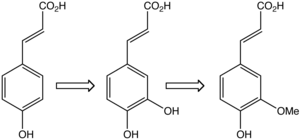咖啡酸
| 咖啡酸 | |
|---|---|

| |

| |
| IUPAC名 3-(3,4-Dihydroxyphenyl 2-propenoic acid 3,4-Dihydroxy-cinnamic acid trans-Caffeate 3,4-Dihydroxy-trans-cinnamate) (E)-3-(3,4-dihydroxyphenyl)-2-propenoic acid | |
| 识别 | |
| CAS号 | 331-39-5 ? |
| PubChem | 689043 |
| ChemSpider | 600426 |
| SMILES |
|
| InChI |
|
| InChIKey | QAIPRVGONGVQAS-DUXPYHPUBE |
| 性质 | |
| 化学式 | C9H8O4 |
| 摩尔质量 | 180.16 g·mol⁻¹ |
| 密度 | 1.478 g/cm³ |
| 熔点 | 223-225 °C |
| λmax | 327[1] nm |
| 危险性 | |
GHS危险性符号 
| |
| GHS提示词 | Warning |
| H-术语 | H315, H319, H335, H351, H361 |
| P-术语 | P201, P202, P261, P264, P271, P280, P281, P302+352, P304+340, P305+351+338, P308+313, P312, P321, P332+313 |
| NFPA 704 | |
| 相关物质 | |
| 相关化学品 | 绿原酸 奎尼酸 |
| 若非注明,所有数据均出自标准状态(25 ℃,100 kPa)下。 | |
咖啡酸(英语:Caffeic acid)是一种归属于羟基肉桂酸的有机化合物,同时具有酚羟基和丙烯酸两种官能团结构。因为咖啡酸是生物合成植物生物质及其残留物的主要组分之一木质素的关键中间体,所以它广泛存在于各种植物中[2]。它可以在热水和乙醇中溶解,冷水中微溶。常温下为黄白色结晶体。
自然中的含量
[编辑]自然界中,咖啡酸可以在蓝桉的树皮中找到[3],也可以在淡水蕨类槐叶苹[4]或桑黄蘑菇中发现[5]。
食物中的含量
[编辑]咖啡酸在咖啡中的含量非常低,仅为0.03毫克/ 100毫升。它是摩洛哥坚果油所含的主要天然酚类之一[6],在一些草药,特别是百里香、鼠尾草和留兰香中咖啡 酸的含量较高(约20mg/100g)。在锡兰肉桂和八角茴香中的含量约22mg/100g。 向日葵种子中的咖啡酸含量较高(8mg/100g),在红葡萄酒存在一定量的咖啡 酸(1.88mg/100ml),苹果酱,杏和李子中也含有咖啡酸(1mg/100g)。 南美州的草药巴拉圭冬青中也有相当高含量的咖啡酸(基于薄层色谱密度测定[7]和高效液相色谱法[8]测得的含量为150mg /100g)。同时也存在于大麦谷物中[9]。
代谢途径
[编辑]生源合成
[编辑]咖啡酸的生源合成是从绿原酸的香豆酸酯(酯化的侧链醇)经羟基化产生的。 这种羟基化过程产生莽草酸的咖啡酸酯,进而转化为绿原酸。 它是阿魏酸,松柏醇和芥子醇的前体,它们是形成木质素的重要结构单元[2]。
许多种植物能产生咖啡酸及其衍生物咖啡酸苯乙醇酯[10]。
生物转化
[编辑]咖啡因O-甲基转移酶是负责将咖啡酸转化为阿魏酸的酶。咖啡酸和相关的邻二酚被组织提取物中的邻二酚氧化酶快速氧化[11]。
药理作用
[编辑]在体外研究和动物模型中发现咖啡酸具有多种潜在的药理作用,通过氧化机制咖啡酸对人HT-1080纤维肉瘤细胞系中的对癌细胞增殖的抑制作用。[12] 咖啡酸在体外和活体内都是一种抗氧化剂[10]。咖啡酸还显示出免疫调节和抗炎活性,咖啡酸能使黄曲霉毒素产量降低超过95%,优于其他抗氧化剂。研究表明否则触发黄曲霉产生黄曲毒素的应激氧化可被咖啡酸阻碍。 对咖啡酸致癌性的研究具有混合的结果[13]。 一部分研究结果表明它抑制致癌作用,另一部分结果显示咖啡酸有致癌作用[13]。对大鼠进行高剂量咖啡酸的口服给药会引起胃乳头状瘤[13]。在相同的研究中,高剂量包含咖啡酸的组合抗氧化剂则能显著减少相同种类大鼠结肠肿瘤的生长[13]。在一些危险物数据表中咖啡酸被列为潜在致癌物,它已被国际癌症研究机构列为2B类致癌物(“可能对人类致癌”)[14]。一些研究数据显示,大鼠肠道中的细菌可能改变咖啡酸代谢产物的形成[15][16]。
化学性质
[编辑]咖啡酸易于自动氧化。谷胱甘肽以及硫醇类化合物(例如半胱氨酸,巯基乙酸或甲琉酚)或抗坏血酸对咖啡酸的褐变和消失具有抑制作用[17],咖啡酸的褐变是由邻二酚被氧化为邻二醌造成的。在酸性条件下用高碘酸钠对咖啡酸进行化学氧化会生成具有呋喃结构的二聚体(2,5-(3',4'-二羟基苯基)四氢呋喃3,4-二羧酸的异构体)[18]。使用辣根过氧化物酶/过氧化氢的氧化系统能使咖啡酸聚合[19]。
其他用途
[编辑]咖啡酸也用于蛋白质的基质辅助激光解吸/电离质谱分析的辅助基质[20]。
同分异构体
[编辑]咖啡酸有三个同属于羟基苯丙烯酸的同分异构体,分别是:
- 伞形酸(2,4-二羟基肉桂酸)
- 2,3-二羟基肉桂酸
- 2,5-二羟基肉桂酸
参考文献
[编辑]- ^ Gould, Kevin S.; Markham, Kenneth R.; Smith, Richard H.; Goris, Jessica J. Functional role of anthocyanins in the leaves of Quintinia serrata A. Cunn.. Journal of Experimental Botany. 2000, 51 (347): 1107–1115 [2017-02-05]. PMID 10948238. doi:10.1093/jexbot/51.347.1107. (原始内容存档于2009-06-03).
- ^ 2.0 2.1 Boerjan, Wout; Ralph, John; Baucher, Marie. Ligninbiosynthesis. Annual Review of Plant Biology. 2003, 54: 519–546 [2017-02-05]. PMID 14503002. doi:10.1146/annurev.arplant.54.031902.134938. (原始内容存档于2021-12-04).
- ^ Santos, Sónia A. O.; Freire, Carmen S. R.; Domingues, M. Rosário M.; Silvestre, Armando J. D.; Pascoal Neto, Carlos Pascoal. Characterization of Phenolic Components in Polar Extracts of Eucalyptus globulus Labill. Bark by High-Performance Liquid Chromatography–Mass Spectrometry. Journal of Agricultural and Food Chemistry. 2011, 59 (17): 9386–93. PMID 21761864. doi:10.1021/jf201801q.
- ^ Choudhary, M. Iqbal; Naheed, Nadra; Abbaskhan, Ahmed; Musharraf, Syed Ghulam; Siddiqui, Hina; Atta-Ur-Rahman. Phenolic and other constituents of fresh water fern Salvinia molesta. Phytochemistry. 2008, 69 (4): 1018–23. PMID 18177906. doi:10.1016/j.phytochem.2007.10.028.
- ^ Lee, Y.-S.; Kang, Y.-H.; Jung, J.-Y.; Lee, Sanghyun; Ohuchi, Kazuo; Shin, Kuk Hyun; Kang, Il-Jun; Park, Jung Han Yoon; Shin, Hyun-Kyung; Soon, Sung. Protein glycation inhibitors from the fruiting body of Phellinus linteus. Biological & Pharmaceutical Bulletin. October 2008, 31 (10): 1968–1972 [2017-02-04]. PMID 18827365. doi:10.1248/bpb.31.1968. (原始内容存档于2012-12-19).
- ^ ., Z. Charrouf; ., D. Guillaume. Phenols and Polyphenols from Argania spinosa. American Journal of Food Technology. 2007, 2 (7): 679 [2017-02-04]. doi:10.3923/ajft.2007.679.683. (原始内容存档于2020-10-20).
- ^ Determination of Flavonoids, Phenolic Acids, and Xanthines in Mate Tea (Ilex paraguariensis St.-Hil.). [2017-02-04]. doi:10.1155/2013/658596. (原始内容存档于2019-08-23).
- ^ Chemical Composition and Antioxidant Activity of Yerba-Mate (Ilex paraguariensis A.St.-Hil., Aquifoliaceae) Extract as Obtained by Spray Drying. Journal of Analytical Methods in Chemistry. [2017-02-04]. doi:10.1021/jf2008343. (原始内容存档于2019-12-02).
- ^ Quinde-Axtell, Zory; Baik, Byung-Kee. Phenolic Compounds of Barley Grain and Their Implication in Food Product Discoloration. J. Agric. Food Chem. 2006, 54 (26): 9978–9984 [2017-02-04]. PMID 17177530. doi:10.1021/jf060974w. (原始内容存档于2021-05-06).
- ^ 10.0 10.1 Olthof, M. R.; Hollman, P. C.; Katan, M. B. Chlorogenic acid and caffeic acid are absorbed in humans. J. Nutr. January 2001, 131 (1): 66–71 [2017-02-05]. PMID 11208940. (原始内容存档于2020-06-26).
- ^ Pierpoint, W. S. o-Quinones formed in plant extracts. Their reactions with amino acids and peptides. Biochem. J. 1969, 112: 609–616. doi:10.1042/bj1120609.
- ^ Rajendra Prasad, N.; Karthikeyan, A.; Karthikeyan, S.; Reddy, B. V. Inhibitory effect of caffeic acid on cancer cell proliferation by oxidative mechanism in human HT-1080 fibrosarcoma cell line. Mol Cell Biochem. Mar 2011, 349 (1–2): 11–19. doi:10.1007/s11010-010-0655-7.
- ^ 13.0 13.1 13.2 13.3 Hirose, M.; Takesada, Y.; Tanaka, H.; Tamano, S.; Kato, T.; Shirai, T. Carcinogenicity of antioxidants BHA, caffeic acid, sesamol, 4-methoxyphenol and catechol at low doses, either alone or in combination, and modulation of their effects in a rat medium-term multi-organ carcinogenesis model (PDF). Carcinogenesis. 1998, 19 (1): 207–212. PMID 9472713. doi:10.1093/carcin/19.1.207.
- ^ Agents Classified by the IARC Monographs (页面存档备份,存于互联网档案馆), International Agency for Research on Cancer
- ^ Peppercorn, M. A.; Goldman, P. Caffeic acid metabolism by gnotobiotic rats and their intestinal bacteria. Proceedings of the National Academy of Sciences. 1972, 69 (6): 1413–1415 [2017-02-05]. PMC 426714
 . PMID 4504351. doi:10.1073/pnas.69.6.1413. (原始内容存档于2008-08-08).
. PMID 4504351. doi:10.1073/pnas.69.6.1413. (原始内容存档于2008-08-08).
- ^ Gonthier, M.-P.; Verny, M.-A.; Besson, C.; Rémésy, C.; Scalbert, A. Chlorogenic acid bioavailability largely depends on its metabolism by the gut microflora in rats. Journal of Nutrition. 1 June 2003, 133 (6): 1853–1859 [2017-02-05]. PMID 12771329. (原始内容存档于2009-04-08).
- ^ Cilliers, Johannes J. L.; Singleton, Vernon L. Caffeic acid autoxidation and the effects of thiols. J. Agric. Food Chem. 1990, 38 (9): 1789–1796 [2017-02-05]. doi:10.1021/jf00099a002. (原始内容存档于2019-12-02).
- ^ Fulcrand, Hélène; Cheminat, Annie; Brouillard, Raymond; Cheynier, Véronique. Characterization of compounds obtained by chemical oxidation of caffeic acid in acidic conditions. Phytochemistry. 1994, 35 (2): 499–505. doi:10.1016/S0031-9422(00)94790-3.
- ^ Xu, Peng; Uyama, Hiroshi; Whitten, James E.; Kobayashi, Shiro; Kaplan, David L. Peroxidase-Catalyzed in Situ Polymerization of Surface Orientated Caffeic Acid. J. Am. Chem. Soc. 2005, 127 (33): 11745–11753 [2017-02-05]. doi:10.1021/ja051637r. (原始内容存档于2019-11-30).
- ^ Beavis, R. C.; Chait, B. T. Cinnamic acid derivatives as matrices for ultraviolet laser desorption mass spectrometry of proteins. Rapid Commun. Mass Spectrom. Dec 1989, 3 (12): 432–435 [2017-02-05]. PMID 2520223. doi:10.1002/rcm.1290031207. (原始内容存档于2017-08-27).


